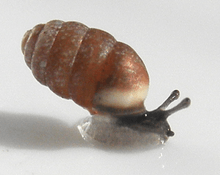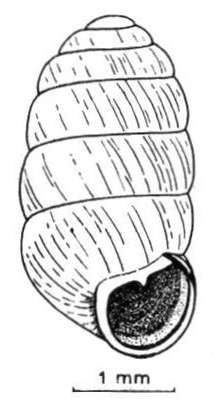Pupilla muscorum
Pupilla muscorum, commonly known as the Moss Chrysalis snail[1] or widespread column,[4] is a species of minute air-breathing land snail, a terrestrial pulmonate gastropod mollusk or micromollusk in the family Pupillidae.
| Pupilla muscorum | |
|---|---|
 | |
| A right side view of a live Pupilla muscorum | |
 | |
| Six shells of Pupilla muscorum, scale bar in mm | |
| Scientific classification | |
| Kingdom: | |
| Phylum: | |
| Class: | |
| (unranked): | clade Heterobranchia clade Euthyneura clade Panpulmonata clade Eupulmonata clade Stylommatophora informal group Orthurethra |
| Superfamily: | |
| Family: | |
| Genus: | |
| Species: | P. muscorum |
| Binomial name | |
| Pupilla muscorum | |
| Synonyms[3] | |
Taxonomy
A variety Pupilla muscorum var. pratensis Clessin, 1871 considered as ecophenotype of Pupilla muscorum was elevated to its species level Pupilla pratensis in 2009.[5]
Description
The shell is usually light brown, varies from reddish brown to horny grey, weakly striated or almost smooth, 5–6.5 weakly convex whorls, suture not very deep (deep suture is presented in Pupilla sterrii – see picture below), aperture usually with well-developed lip, cervical callus strongly developed, like a dam, parietal tooth usually present, palatal tooth sometimes too.[3]
Pupilla muscorum differs from Pupilla pratensis with which it lives sympatrically, in its thicker, smaller and more slender shell, lighter and more variable colour and stronger apertural lip.[3]
The animal of Pupilla muscorum is small, elliptical, dark with lighter sides and foot, upper tentacles not very long, lower tentacles very short.[3]
The height of the shell is 3.0–4.0 mm. The width of the shell is 1.65–1.75 mm (shell diameter does not vary much).[3]
_(4387607982).jpg) Photo of the shell Pupilla sterrii with deep sutures |
 Drawing of the shell – typical view of Pupilla muscorum with shallow sutures. |
Distribution
This species of land snail occurs in the Northern Hemisphere including almost all of Europe. It is recorded as present in countries and islands including:
- Great Britain. It is threatened by disturbance due to intensification of land use of old calcareous grasslands in Britain.[3]
- Ireland
- lower concern in Austria. Vulnerable in Vorarlberg.[3]
- lower concern in Germany, decreasing (4R) in Bavaria.[3]
- Czech Republic[6]
- Slovakia[6]
- Ukraine[7] and Crimea[8]
- Pakistan[9]
- Michigan, USA[10]
- Utah, USA[4]
- Vermont, USA[11]
Ecology
Pupilla muscorum lives in dry meadows, sand dunes, in open and sunny habitats.[3] Calciphile.[3] In Portugal it is found under stones, dead leaves and in mosses.[3] In Britain it is frequent in sheep-grazed calcareous grasslands.[3] In the Alps in up to 2400 m, in Bulgaria 1200 m.[3]
Ovoviviparous, the species is able to hibernate with its eggs, and can then release eggs with partly grown embryos during more favourable seasons.[3]
References
This article incorporates public domain text from the reference.[3]
- Neubert E. (2013). "Pupilla muscorum". The IUCN Red List of Threatened Species. Version 2014.2. <www.iucnredlist.org>. Downloaded on 29 July 2014.
- Linnaeus C. (1758). Systema Naturae per regna tria naturæ, secundum classes, ordines, genera, species, cum characteribus, differentiis, synonymis, locis. Tomus I. Editio decima, reformata. pp. [1–4], 1–824. Holmiae. (Salvius).
- "Species summary for Pupilla muscorum". AnimalBase. Last modified 30-01-2010, accessed 30 July 2010.
- "Pupilla muscorum". Utah Division of Wildlife Resources. Archived from the original on May 19, 2017. Retrieved May 19, 2017.
- von Proschwitz T., Schander C. , Jueg U. & Thorkildsen S. (2009). "Morphology, ecology and DNA-barcoding distinguish Pupilla pratensis (Clessin, 1871) from Pupilla muscorum (Linnaeus, 1758) (Pulmonata: Pupillidae)". Journal of Molluscan Studies 75(4): 315–322. doi:10.1093/mollus/eyp038.
- (in Czech) Horsák M., Juřičková L., Beran L., Čejka T. & Dvořák L. (2010). "Komentovaný seznam měkkýšů zjištěných ve volné přírodě České a Slovenské republiky. [Annotated list of mollusc species recorded outdoors in the Czech and Slovak Republics]". Malacologica Bohemoslovaca, Suppl. 1: 1–37. PDF.
- Balashov I. & Gural-Sverlova N. 2012. An annotated checklist of the terrestrial molluscs of Ukraine. Journal of Conchology. 41 (1): 91–109.
- Leonov S. "Illustrated Check-list of Crimean Terrestrial Molluscs Иллюстрированный список наземных моллюсков Крыма". accessed 30 July 2014.
- Pokryszko B. M., Auffenberg K., Hlaváč J. Č. & Naggs F. (2009). "Pupilloidea of Pakistan (Gastropoda: Pulmonata): Truncatellininae, Vertigininae, Gastrocoptinae, Pupillinae (In Part)". Annales Zoologici 59(4): 423-458. doi:10.3161/000345409X484847.
- Michigan Natural Features Inventory. (2007). "Pupilla muscorum" Archived 2009-01-05 at the Wayback Machine. Rare Species Explorer (Web Application). Available online at http://mnfi.anr.msu.edu/explorer accessed 26 February 2012. archive.
- "Pupilla muscorum (Linnaeus, 1758) Widespread Column". accessed 30 July 2014.
External links
![]()
